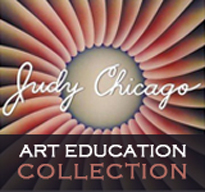Forum Replies Created
-
AuthorPosts
-
halvorson
ParticipantI love carrying the symbolic meaning of a circle into the art classroom setting: wholeness, revolution, infinity, inclusion, completion. Conversations can happen in a circle to allow everyone to have face to face interaction and feel present in the discussion. These circle conversations occur on the rug in my K-6 classroom. To promote the idea of the circle concept in artmaking, I’ve arranged the student tables in a circle as well. It doesn’t have the exact same effect since students are around the tables themselves- leading to some backs toward the center of the circle. However, this layout promotes teaching in the round, which allows me to constantly circulate the room and guide students as necessary to encourage their success. Students are also able to hear one another as they respond due to circle set up whereas communication was impaired in the linear layout.
halvorson
ParticipantArt gives us a voice. When art education provides an avenue for students to explore, challenge, reflect, and respond, the students are empowered to use their voices for expression and activism.
halvorson
ParticipantI teach art to students in grades K-6. Even at such young ages, the students have been conditioned to search for the “right answer.” When I tell them that there is no wrong answer in art, I get looks that range from confusion to utter horror. Young students look to learn through everything they do. Educators, parents, siblings, friends: everyone is a teacher to them. To circumvent my position as authority figure in the art studio, I try to engage my students in lessons we can “learn together.” I write lesson plans as an outline of developmentally appropriate concepts that I’d like to discuss with the class, then open the lesson with questions to get the students talking about what they already know. Through this discussion they share ideas and build upon their knowledge, incorporated with the content I planned, then the students formulate their own project. To promote their success, I support and guide wherever necessary, but encourage my students to use their own thoughts and creativity to shape their artmaking.
April 7, 2015 at 10:57 am in reply to: 6. Why so much emphasis on hands-on artmaking in both k-12 and undergraduate art education? #4298halvorson
ParticipantThe age of electronics has taken away much of the time that children used to spend drawing/coloring/creating at home. I see students who start Kindergarten not knowing how to hold a crayon or pencil let alone scissors, but put an iPad or video game controller in their hands and they’re completely comfortable. The majority of students in art education will not become artists or art educators, so the hands on experience is essential for fine motor development. Once students have gained a foundation of skills, they can participate and feel successful in limitless topics taught through their art education.
-
AuthorPosts
